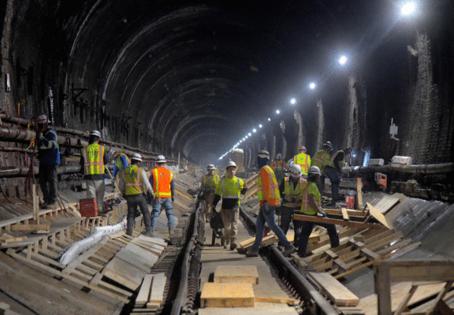Underneath the busy Baltimore streets, the Howard Street Tunnel gets its makeover
Published in News & Features
BALTIMORE — A squad of construction workers descend daily under the streets of Baltimore. They labor deep down, in the semi-secret and highly restricted chamber known as the Howard Street Tunnel.
The massive brick-lined tube, hand-dug in the 1890s under the bed of downtown Baltimore’s Howard Street, has been closed to freight rail traffic since February for this complex infrastructure makeover.
“It’s definitely a unique project,” says Derek Mihaly, CSX Railroad’s Mid-Atlantic director of construction who is heading the effort.
The work runs 24 hours a day, seven days a week. Along the way, the tunnel got WiFi and toilets.
It’s an eerie and oddly cool place, no matter how hot it is upstairs. There’s not a trace of graffiti and only the atmospheric smudges of a half century of locomotive coal smoke color the brick walls. It seems enormous and never-ending. It’s meant for heavy business and shares nothing with a traditional highway or subway tunnel.
Mihaly said that just this week, the workers achieved the 47% completion mark to lower the historic, 1895 rail tunnel by 2 feet. The tunnel is now officially lowered from Mount Royal Station near the Joseph Meyerhoff Symphony Hall to Centre Street, a spot west of the Walters Art Museum.
Once this brick-lined tube is deepened and rails re-laid, it will be capable of carrying double stacks of steel shipping containers from M&T Bank Stadium to North Baltimore and a vital connection to Baltimore’s Seagirt Marine Terminal Intermodal Container Facility.
“We found the original tunnel in great condition,” said Mihaly.
One surprise, he said, was the solid rock encountered at Mount Royal Avenue. The rest of the way was the same clay you encounter when you dig a hole in and around Baltimore.
He explained that his contractors built a machine for this job that clears out the base debris (the brick tunnel flooring) and then inserts a new concrete base.
“That base is shaped like the bottom half of a stop sign,” Mihaly said.
The work is costly. The $466 million cost is shared by the State of Maryland, CSX, the Federal Railroad Administration, and the Pennsylvania Department of Transportation. Within that cost, the State of Maryland has pledged $247.5 million for the project. Several bridges will also have to be altered, including a city-owned span at Sisson Street.
Pennsylvania has pledged to alter its bridges where the railroad passes.
This tunnel modification will accommodate the height of double-stacked container trains and give the CSX a speedy route to the Midwest.
Two construction entities are doing the work — Skanska USA (a firm founded in Sweden) and Joseph B. Fay, based in Glen Burnie. The precast concrete sections were fabricated in Chesapeake, Virginia.
The tunnel passes on a north-south course through downtown Baltimore. The tracks connect Washington, Western Maryland and Philadelphia, among other destinations. Because of its port, Baltimore is a major traffic point for the railroad, founded as the Baltimore and Ohio here in 1827.
The old Baltimore and Ohio Railroad built the tunnel in 1895 to get its trains to Philadelphia and Jersey City. Passenger service along this route ended in 1958, with only a summertime race fans’ train bound for Delaware Park after that.
But the tunnel had famous travelers. Many presidents rode this line — it was a favorite of Franklin D. Roosevelt — and Queen Elizabeth and Prince Philip in 1957.
The tunnel is listed on the National Register of Historic Places and was scientifically innovative for the 1890s. It was fitted to power special electric locomotives that were attached to steam locomotives. The mighty electric engines pulled trains from Camden Station to Waverly, where they switched off and the steam locomotives pressed on to Philadelphia.
Freight trains are expected to begin running later this year, Mihaly said. It may take a while longer to see the completion of a replacement bridge at Harford Road and a partially reconstructed North Avenue Bridge.
The North Avenue site has several challenges. While the CSX tracks run exposed in daylight, they must pass under the bridge’s stone arch and on top of another underground tube — the Amtrak and MARC train Frederick Douglass Tunnel.
Persons working in downtown office buildings, or living near the Hippodrome Theatre, or riding light rail, observe no active construction activity. And yet, under some of the city’s busiest streets, workers are laboring only about 40 feet away.
The place to observe the staging site for the operation is in the Remington neighborhood, near West 26th and Sisson streets. On the south end, the removed clay and rock are being stored at the CSX property at Mount Winans at Gable Avenue.
“From the top, there is no idea that anything is happening,” said Mihaly.
“And that’s a good thing,” he quickly adds.
©2025 Baltimore Sun. Visit baltimoresun.com. Distributed by Tribune Content Agency, LLC.







Comments